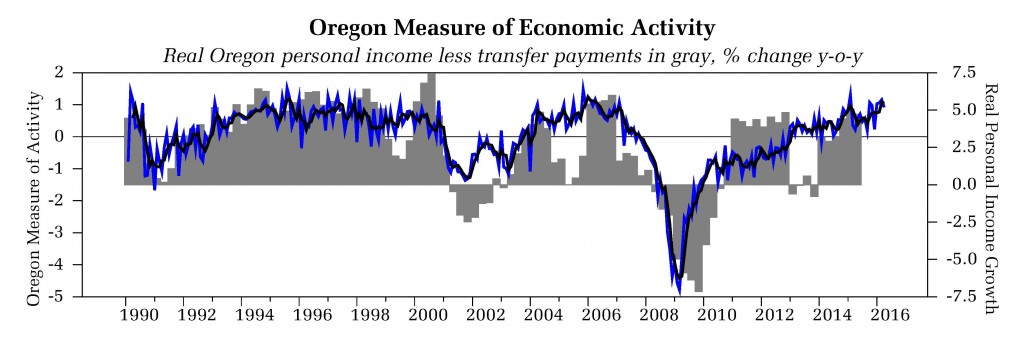The April 2016 State of Oregon Economic Indexes of was released today. Full report is available here. We thank KeyBank for their generous support of this project

The Oregon economy sustained its momentum in April despite a drag from manufacturing indicators. Highlights of the report include:
- The Oregon measure of economic activity edged down from an upwardly revised March figure, while the three-month moving average, which smooths month-to-month volatility in the measure was effectively unchanged at 1.04, where “zero” indicates average growth over the 1990-present period.
- The manufacturing sector again contributed negatively, held back in part by weaker employment numbers. Soft manufacturing activity currently affects firms nationwide and is more significant in sectors exposed to a stronger dollar or the low energy prices. Note that both factors have been reversing themselves in recent months, suggesting that the drag from manufacturing will lessen in the second half of the year.
- The UO measure of economic activity suggests a pace of growth similar to that experienced in other post-1990 expansions.
- The University of Oregon Index of Economic Indicators was up 0.2% in April. The UO Index incorporates revisions to capital goods orders data this month; the Index remained qualitatively unchanged by the revisions. Initial unemployment claims fell while employment services payrolls (largely temporary help workers) rose; both indicators suggest overall job growth is set to continue.
- Residential building permits and consumer sentiment both edged back while hours worked in manufacturing and the weight distance tax, a measure of trucking activity gained. Core manufacturing orders continued to trend down; as noted earlier, the sector is under pressure from a strong dollar and weak energy prices.
Together, these indicators suggest ongoing growth in Oregon at an above average pace of activity. The ongoing US economic expansion provides sufficient support to sustain Oregon’s economy for the foreseeable future.

